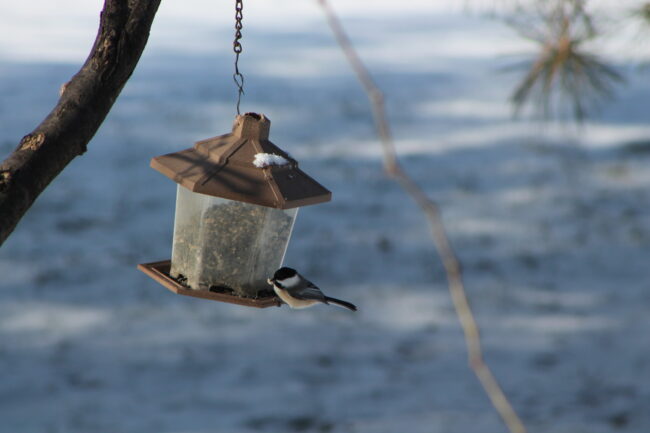Margaret Murphy
Horticulture Educator for Chippewa, Dunn, & Eau Claire Counties
UW-Madison Extension
With winter landscapes often taking a turn toward the bleak, I am grateful to the little, feathered critters that remain behind to brave our cold winters. They add color, interest and animation to an otherwise static and, usually, white backdrop.
I hold birds in very high esteem. I am in awe of how they manage to survive unpredictable and often rather harsh environments. This strong appreciation began during a previous job where I spent a lot of time on the Atlantic Ocean. I had the opportunity to observe numerous marine birds. Many of them spent months, if not years, out at sea returning to land only to breed. I couldn’t imagine weathering a nor’easter out at sea and not being able to take shelter on land.

Well, my admiration is no less for the little songbirds that stay through a Wisconsin winter.
One of my favorite birds to see in the yard is the black-capped chickadee. Described in Cherokee folklore as a ‘bringer of news’, this chatty bird is more often heard before it is seen. Its familiar call “chick-a-dee-dee” can indicate alarm (the more “dee” notes attached to the call, the stronger the alarm). Black-capped chickadees are easy to spot. Both the male and female sport a black cap, a black bib, white cheeks, and light, ocher- colored sides.
Weighing no more than half an ounce, black-capped chickadees are one of the smallest songbirds to grace our state year-round but don’t be fooled by their delicate appearance. Black-capped chickadees have an assortment of adaptations to help them manage through a Wisconsin winter such as donning a dense winter coat and storing more body fat to keep them well insulated. To cope with extremely cold nights, they can lower their body temperature in a controlled manner to conserve energy.
To defend against the cold, black-capped chickadees need to get plenty to eat so they take great care to ensure that they have an available food source by storing seeds and other food items. Each item is given its own hiding spot. It can be up to a month or more before they retrieve their secreted food. Fortunately, black-capped chickadees have excellent memories and can keep track of thousands of hiding places.
Black-capped chickadees rely on a diet rich in insects, caterpillars, and spiders. In winter, their diet changes to include more seeds and fruit. So, during this time of year, chickadees are often frequent visitors to bird feeders. Feeder favorites include black oil sunflower seeds and peanuts.
Suet is another sought-after treat as the weather turns cold. Suet is a high-energy food source and is eaten by a large variety of birds in the winter. Having suet cakes available can encourage sightings of black-capped chickadee as well as other insect eating birds like nuthatches and woodpeckers.
So, the next time you are out and about listen for the call of the black-capped chickadee and see if you can hear what this ‘bringer of news’ has to say.
To attract birds like black-capped chickadees to your yard, consider landscaping with plants that provide them with year-round food and shelter. Your local county Extension office can help you determine what plants may work best for you and our feathered friends.
For more information on how to be a bird friendly gardener, visit the Wisconsin Horticulture Division of Extension website, https://hort.extension.wisc.edu/articles/beyond-birdfeeders-how-to-be-a-bird-friendly-gardener/.
Information sources included: All About Birds, (https://www.allaboutbirds.org/guide/Black-capped_Chickadee/overview), and the National Wildlife Federation (https://www.nwf.org/Magazines/National-Wildlife/2008/Backyard-Birding).





